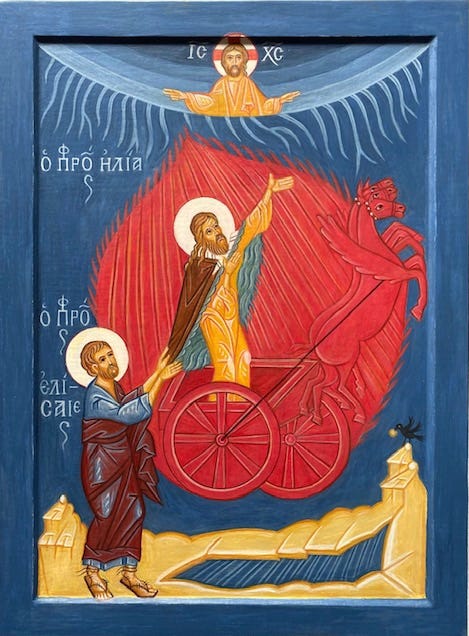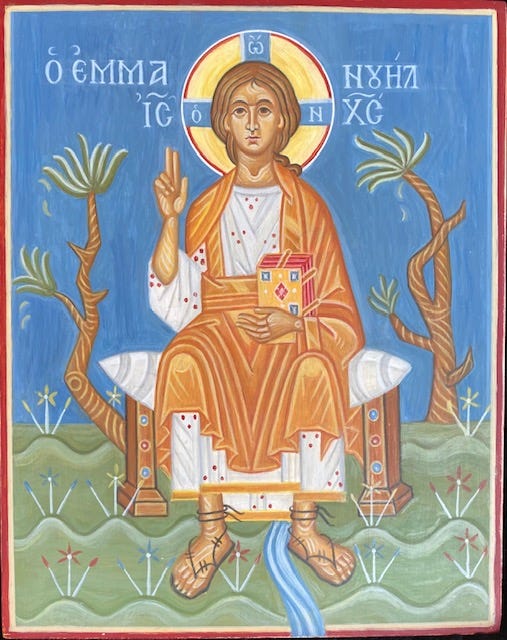By Way of an Introduction
Remembering a young student in Athens...
Before launching into deeper waters with this new endeavor, I’d like to tell a story of my early days starting out as an iconographer. I will get to more pertinent matters in upcoming posts. But I’d like to begin on a somewhat personal note. (As an aside, the first couple of posts will be free for everyone to read; after that, it will be available to subscribers.)
As a young student, I was lucky enough to travel to Greece. It was a country completely new to my experience. The landscape, the weather, the food, and the way people related to each other were all different from anything I had previously known. And of course, the art – ancient as it was – was new to me. It made a profound impression on me. The architecture and sculptures impressed me, but what especially moved me was the Byzantine art that I saw in museums, churches, and monasteries.
I particularly remember one late evening in Athens when I entered a church in the center of the city. It took some time to get used to the semi-darkness of the building. After a while, my eyes adjusted and I could make out figures in the art, and then, little by little, I was able to recognize Gospel scenes – familiar to me since childhood – on the walls. I stood there and took in the solemn atmosphere. I felt that I was part of those stories I knew so well. It was as if I had entered into the events and become one among the crowds surrounding Jesus. It was an experience that changed my life forever. Since then, the medieval iconography that I witnessed there has become a vital focus for me, both personally and professionally.
Four years later, in 1985, I returned to Athens with a Greek scholarship. I had been given a place to study Byzantine art at the Polytechnion, the Academy of Fine Arts in Athens. I had to register at a certain place in the center of the city. When I arrived, I was informed that there was no place for me in the class. Well, in this situation I had no choice but to mobilize all the courage I had within me.
I replied: "I have received a Greek state scholarship and here’s the paper that proves it. You’ll have to fix this problem.”
The lady behind the desk surveyed me with wide eyes. Then she muttered: "Come back in fourteen days and we'll see if we can sort it out."
For the next two weeks, I visited “my” class every Monday, Wednesday, and Friday evening. I got to know the assistant teacher and showed him photos of my work. The main professor was nowhere to be seen – I was given to understand that he had a stomach ulcer. Finally, the assistant teacher understood that I was serious about learning the Greek way of painting icons. He asked me to find an easel, squeeze myself into a corner between two other students, and get started. So it was that, finally, I was on the inside. Later I heard that I was formally accepted into the school, and all was well.
One of the best pieces of advice I received before traveling to Greece was that I shouldn't take a "no" for a "no.” As my story demonstrates, this would prove to be useful. It not only worked for entering my course of study. It had application elsewhere. If, for example, I came to an isolated monastery and needed to spend the night, the usual answer was, at first, that no rooms were available. Instead of leaving straightway, however, I would remain outside the door there for a while. Eventually, a porter or the abbot would come out to investigate this presumptuous newcomer. On one occasion, an abbot wanted to see the Norwegian flag on my backpack and ask me about it. During the exchange, I showed him photos of the icons I made — and consequently, a “miracle” occurred. The closed doors opened up, I got accommodations, and the next morning I stayed for breakfast.
***
Click here for a clip from an interview I gave earlier this year.





As an Anglican Priest, ikons have become more and more significant in my life. Thank you for starting this letter
Thank you for initiating this newsletter. I've been strangely drawn to this art form for some time and look forward to deeper understanding and appreciation. Already, you have given me a clue about the formal elements of symbolic realism, and the power of reverse perspective. I await your further posts.